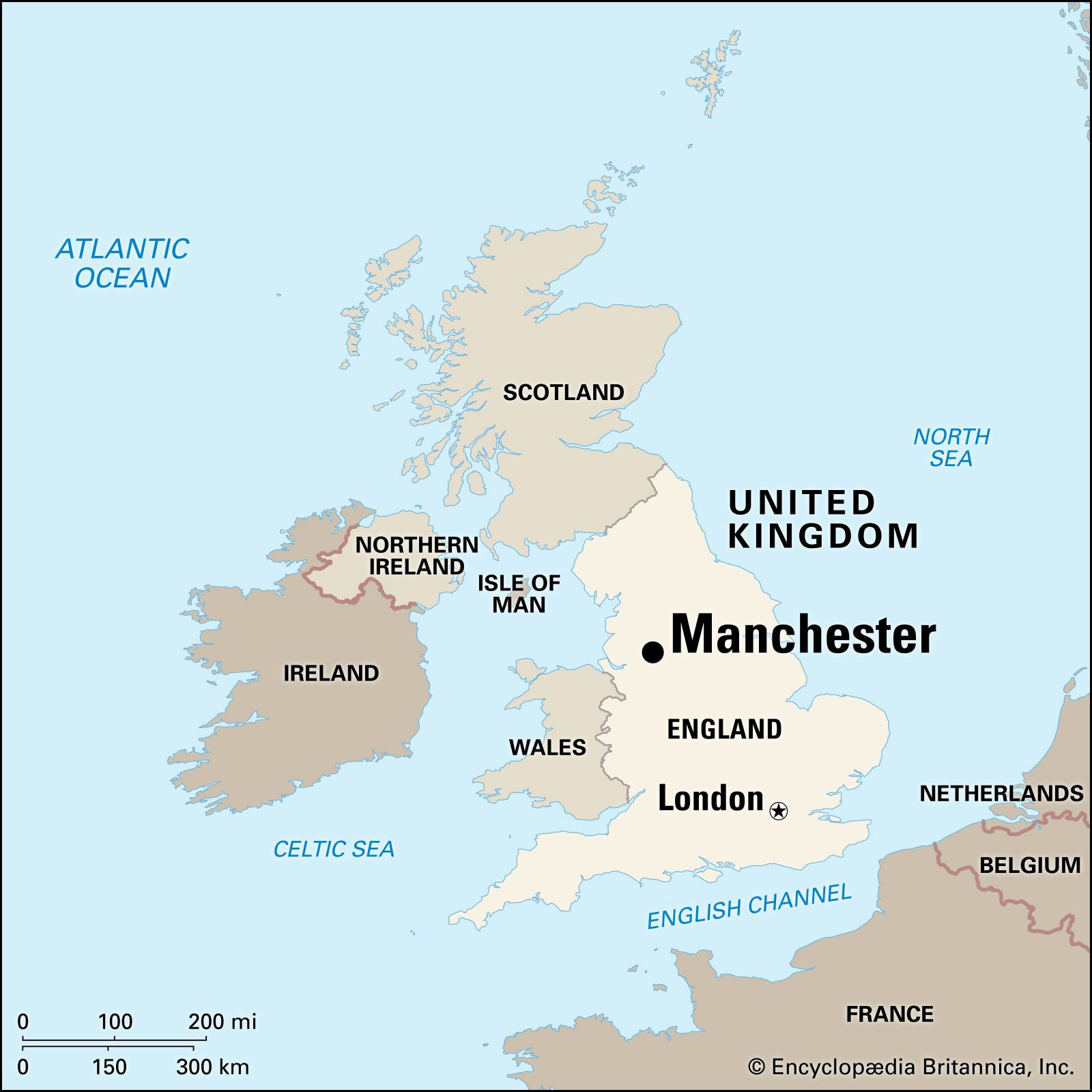Manchester, a city synonymous with vibrant culture, groundbreaking music, and industrial heritage, beckons travelers and knowledge-seekers alike. But Where Is Manchester exactly? Nestled in the northwest of England, this dynamic metropolis is more than just a point on a map; it’s a geographical marvel shaped by unique landscapes and historical forces. Let’s delve into the precise location and geographical context that defines Manchester.
Manchester is situated within the Manchester embayment, a distinct physical unit characterized by a flat plain composed of river gravels and glacial drift. This plain sits at an elevation of 133 feet (40 meters) above sea level. To the east, the slopes of the Pennine range rise, providing a natural boundary, while the upland spur of Rossendale frames the city to the north. This unique topography creates a bowl-like setting, contributing to Manchester’s distinctive regional climate and landscape.
 View of Manchester Cityscape in England
View of Manchester Cityscape in England
Historically, the presence of coal measures beneath much of this plain played a significant role in Manchester’s industrial development. Although mining activities have ceased in the 21st century, the legacy of this geological feature is deeply woven into the city’s fabric. Geographically, Manchester city center lies on the eastern bank of the River Irwell, extending in a north-south direction. This elongated shape is a result of significant territorial expansion during the late 19th and early 20th centuries, reflecting the city’s growth and importance.
Further solidifying its position as a major urban center, Manchester expanded its boundaries in 1930, reaching south of the River Mersey and incorporating a substantial portion of Cheshire. Adjacent to Manchester, to the west and southwest, are the metropolitan boroughs of Salford and Trafford. These three administrative areas form the core of commercial activity in the region. From this central point, Manchester’s suburban sprawl extends predominantly westward and southward, particularly into Cheshire East. To the north and east, a network of smaller industrial towns and suburban developments creates a continuous urban expanse that reaches the foothills of the surrounding uplands. Encircling Manchester near the upland fringes is a ring of historically significant towns. These towns, including Bolton, Bury, and Rochdale to the north, and Oldham, Ashton-under-Lyne, and Stockport to the east, were traditionally pivotal centers of the cotton-spinning industry, highlighting Manchester’s central role in the region’s industrial past and present urban configuration.
Manchester’s urban structure is heavily influenced by its industrial zones. A significant east-west industrial belt bisects the metropolitan area. This zone is home to diverse industries, ranging from petrochemical plants along the Ship Canal near Irlam, to electrical engineering in Trafford Park and Salford, and metal fabrication and machine tool manufacturing in eastern Manchester. In contrast, the industrial areas to the south of the city are more concentrated, featuring planned factory estates in locations like Altrincham and Wythenshawe. To the north and east of Manchester, older industrial areas stretch along railways, river valleys, and former canals. These areas are characterized by electrochemical industries in the Irwell valley, dyestuffs production along the River Irk, and numerous textile mills, many of which have been repurposed for new industrial uses, showcasing the city’s adaptive industrial landscape.
Manchester’s Climate: A Mild and Moist Environment
Understanding where is Manchester also involves considering its climate. Manchester is known for a climate that can be described as mild, moist, and often misty. Its temperate nature means it avoids extreme temperatures, with mild winters averaging in the high 30s Fahrenheit (around 4 degrees Celsius) in January, and cool summers with a July mean temperature in the high 50s Fahrenheit (approximately 15 degrees Celsius). While occasional high-pressure systems can bring cold, clear winter spells or hot summer droughts, these are generally short-lived.
Winds predominantly from the west and south bring frequent, gentle rain, a result of the constant flow of Atlantic weather systems. The annual rainfall, averaging around 32 inches (818 mm), is typical for western Britain, and it’s distributed across approximately half the days of the year. Seasonal variations are subtle, but the months from March to May usually offer the best chances for longer dry periods. The city experiences considerable cloud cover, with the afternoon sky being at least half cloudy on about 70 percent of the days each year, due to moist Atlantic air interacting with the Pennine slopes to the east. This cloud cover naturally limits sunshine hours. Historically, air pollution further reduced sunshine, with the city center recording an unusually low 970 annual sunshine hours up to the 1960s. Fog was another significant aspect of Manchester’s industrial climate, with an average of 55 days of serious fog per year, contributing to higher death rates from respiratory illnesses.
However, Manchester has significantly transformed its climate through effective air pollution control measures. Annual sunshine hours have increased to about 1,300, and serious fog days have decreased to around 20 per year. This improvement has played a crucial role in reducing the incidence of respiratory diseases like bronchitis and tuberculosis, which once contributed to the city’s high death rate.
In conclusion, where is Manchester is not just a simple geographical coordinate, but a location defined by its unique landscape within the Manchester embayment, bordered by the Pennines and Rossendale, shaped by its industrial history, and characterized by a mild, moist climate. This geographical and environmental context is essential to understanding the character and development of this significant English city.
